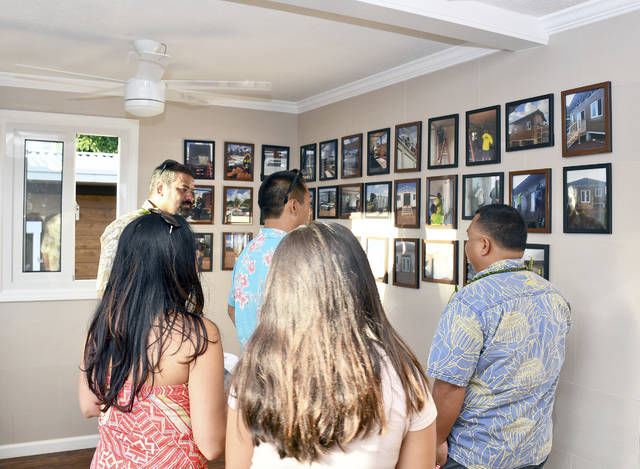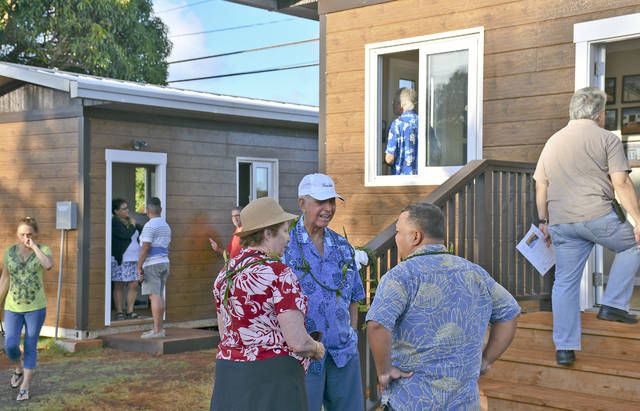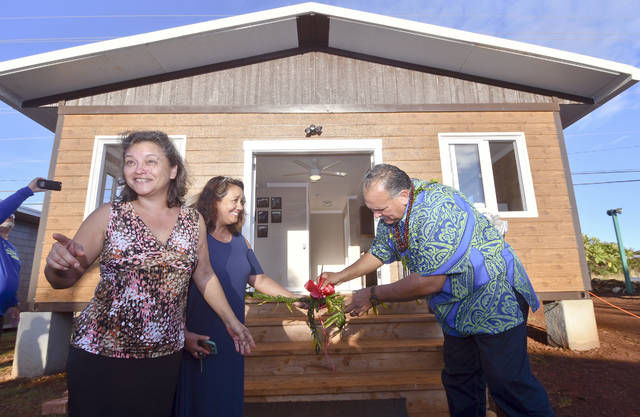ANAHOLA — The blessing of the Tiny Home in Anahola drew a lot of interest from the community. Robin Danner, executive director at the Soverign Council of the Hawaiian Homesteads Assembly, was joined by Michelle Kauhane of the Council for
ANAHOLA — The blessing of the Tiny Home in Anahola drew a lot of interest from the community.
Robin Danner, executive director at the Soverign Council of the Hawaiian Homesteads Assembly, was joined by Michelle Kauhane of the Council for Native Hawaiian Advancement, and Mayor Bernard Carvalho Jr. in untying the symbolic lei marking the completion of the Homestead Tiny Home Pilot Project Sunday afternoon in the golden waning light of sunset at the base of the Kalalea mountains.
“The Hawaiians did it,” Danner said. “This project was inspired following a discussion where we said no one is coming to save the Hawaiians. This is the start of the Tiny Homes.”
Representatives from the Kauai County Council, the Kauai Chamber of Commerce, and Sen. Will Espero, and others listened to the description of the two prefab units blessed by Jason Kerr of Puka’s Ministries.
The homes, including a modular studio and a 3-Flat Pack one bedroom, one bath, with fully functioning kitchen and living area were dedicated off Kuhio Highway in Anahola.
“This is a hybrid house,” Danner said. “Based on container technology, all the materials for the 3-Flat fit into a shipping container to yield a 480-square-foot home that feature galvanized steel exterior and trusses. Everything else is local — including foundation footings, fixtures, exterior and interior doors, electrical and plumbing materials, kitchen cabinets and appliances, and an assortment of lumber and paint to finish.”
The completed 3-Flat one bedroom is priced for $85,000 turnkey, including the locally sourced materials, labor team hours, and project overhead.
“The house took 32 working days to complete,” Danner said. “That includes one day where we needed to use the crane.”
Eric Hudson of the Big Island supervised the construction.
“This home is a perfect additional dwelling unit,” Hudson said. “You can tie in the water and sewer with the existing unit, and it is the perfect size for kupuna who can turn over the main dwelling to the young people and live in this unit, comfortably.”
Financing for the homes will be handled by the Council for Native Hawaiian Advancement, Danner said, noting that using CNHA leveraged capital for a 15-year term, residents put down 5 percent and end up with a $659 monthly payment.
Under the USDA 502 Home Loan, residents end up with a 30-year term with a sliding scale interest and with 0 percent down, come up with an estimated payment of $358.
“We can’t do this without financing,” Danner said. “Michelle Kauhane of CNHA has been tasked to find the funds to make this work.”
Four house plans are available, including a studio covering 160 square feet, a studio at 320 square feet, the one bedroom 3-Flat Pack at 480 square feet, and a two bedroom at 640 square feet.
The attractive price points attracted county and state officials, including Espero who is the chair of the Housing Committee, and Rep. Nadine Nakamura, vice chair of the Housing Committee at the Legislature, who checked out the units to fill the need for affordable housing.
“This can be part of the solution,” Espero said.




